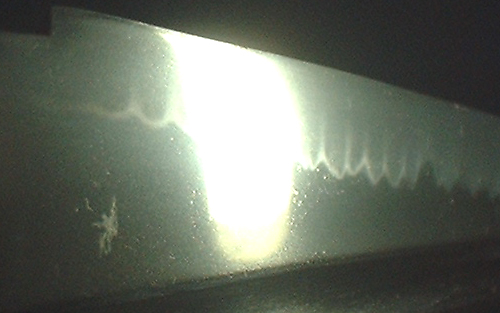blade length 68.4cm, curvature 0.4cm
The tang and the blade about 10cm from the start of hamon is original, but the upper part where hamon disappears has been burnt out by fire accident. The small curvature on the upper part also may be by the burning.

Signature "Etchu(no)kami Fujiwara Kanekuni"
"Kanekuni" is a smith in Tegai school in Yamato province. This Kanekuni is around Empo era (1673 ~ 1681).
The hamon near the tang is very fine, that suggests a good quality blade as its original. Unfortunately we can guess it by the small part of it.

The original hamon is made of Nioi (smallest particles) mainly.

The white pattern on the upper part of the blade is not hamon. It is Hadori that created by polisher.

No hamon.

This blade got fire accident in the past, but the tang and a part of the blade was not burnt out. Therefore the rust condition of the tang is good, and near the starting of the hamon is very fine. The upper part of the blade has no hardening effect, and the shape is destroyed.

When a blade is burnt out, the hamon disappeared at the part. It means the part has lost the hardening effect, and has come back to mild steel as before the hardening work. The curvature also can become smaller, because the stress of the hardening effect disappeared. (=> Actual examples of hardening)
By any reason, this blade is polished up and put in shirasaya. On the burnt out part of the blade, fake hamon is fabricated. Why did someone do such work on this blade wasting much money? There was no purpose except for tricking beginners. The last owner had been tricked with this sword.
Usually, such blade is brought to a smith to take re-hardening. The work is a kind of gamble, but better than castrated blade.